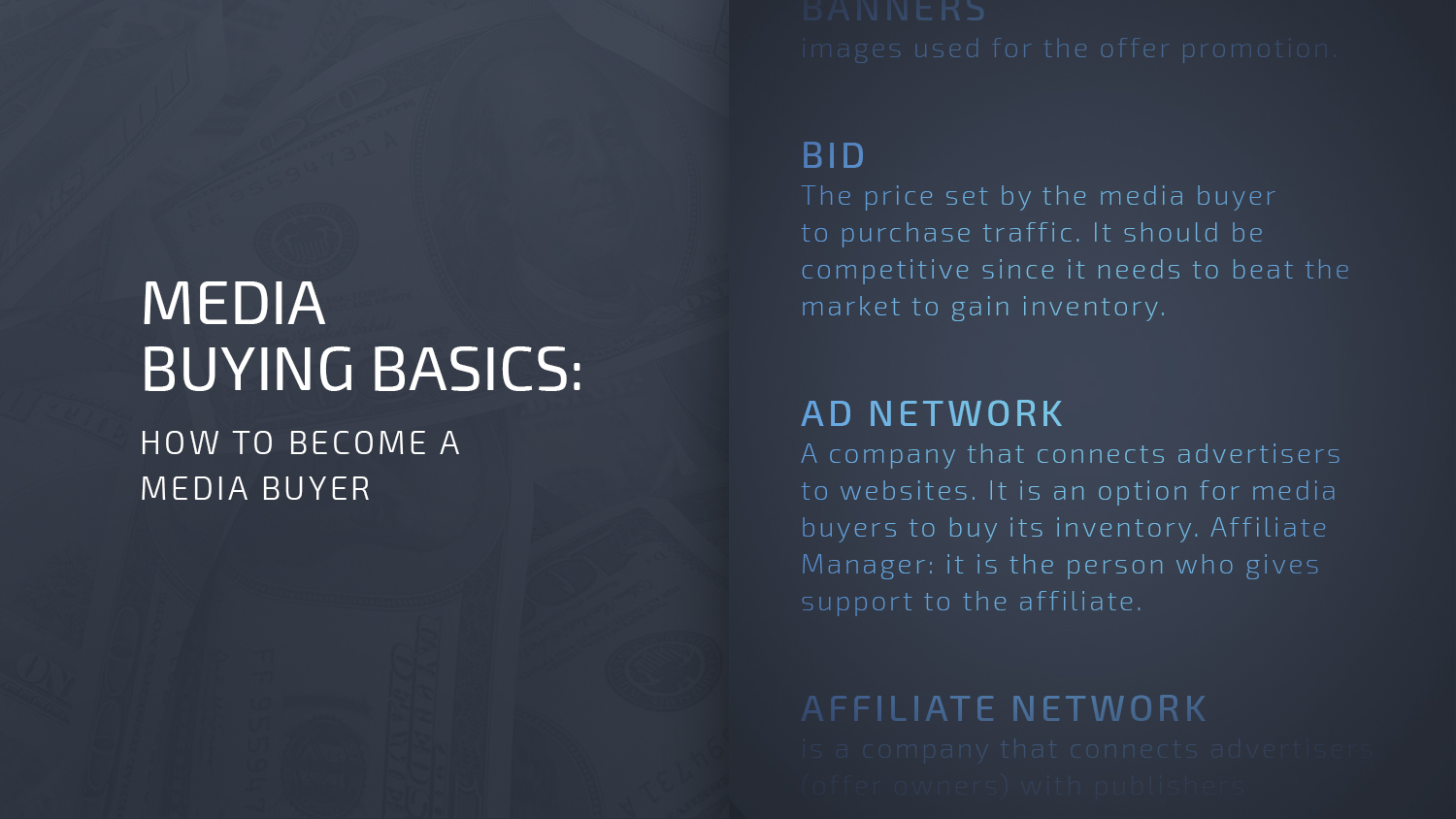Media Buying Beginner’s Mistakes – Part 1 of 5
Last updated on May 16, 2018 by Elena Rudneva 5 min readIntroduction
Mistakes are part of life.
Every day, we make mistakes that help us learn tough lessons, develop our senses and grow, both personally and professionally.
Of course, we’d all prefer not being caught by the same trap that caught other people.
That’s why it’s good to learn from their errors before wasting our time dealing with the consequences.
Here’s a list of common media buying mistakes that beginners should try to avoid in order to be successful!
1. Start Slowly to Avoid Media Buying Mistakes
You cannot embrace the boundless, so don’t try to be everywhere and cover every segment at the beginning.
Just choose one or two countries with the right targeting and explore them fully.
Try to become an expert on a given country, understanding what influences fluctuations in your profit and, most importantly, when you’ll be comfortable managing it.
When you’re comfortable you can then move on and explore other countries.
Remember:
At the beginning, your main goal is getting used to the platform, its traffic and the whole optimization process.
2. Choose Easy Countries
Opt for stable countries with a big amount of traffic and small payouts.
By doing this, you can gather statistics faster and won’t lose a lot of money.
Moreover, you can understand traffic behaviour more easily, so you don’t take any avoidable risks!
3. Launch Several Spots
Don’t stick with only one ad format. One spot can work well for one country but fail in another.
If you launch only one spot and you’re not successful, that doesn’t mean that you can’t get money from that country.
It may simply show that spot was picked wrongly for testing purposes.
That’s why I’d suggest you start with 2 to 3 spots.
This way, you’ll be able to test a country, getting a clear sense of its true potential.
4. Learn to Wait
Don’t get crazy with optimization!
When you launch the campaign it will most likely not be profitable at the beginning.
You’ll be losing money, your heart won’t stand it, and you’ll have an urge to change lots of things as quickly as possible.
Please, don’t do it! Wait! Bear in mind that this is a very important stage.
You’re gathering stats.
The important thing is not to panic and to avoid making changes within the first 3 to 5 days (this all depends on the actual amount of traffic you have).
You need to have relevant stats in order to evaluate the traffic’s behavior.
If you don’t, you may risk making changes without considering delayed conversions, low-performance hours, or even days.
Have patience. You need to bear the idea of “losing money”.
Of course you don’t need to take patience too far:
If you see that all your money was “eaten” by a “bad” website, or a non-convertible banner, just do the right thing and cut it.
5. Don’t Optimize too Often
After optimizing, give your traffic a few days to work, letting your performance adapt to changes.
Remember the time in which you made a change and what was it that influenced your performance.
Here’s a cool tip: always write what you’ve changed on which day (bid, capping, banner, etc.).
Then, a couple of days after, check the impact of that particular change.
Did the volume increase? Is the performance better? So on and so forth.
By writing your notes you’ll have a clear picture of what can be impacted by what. It’s important for you to be organized; to choose the correct period, and the tools for further optimization.
6. Don’t Change Everything Possible at the Same Time
When you make some strategic changes (like changing of bid/cap/banner/targeting) you need to understand what influenced your performance.
That’s why you should always wait after making a change.
You need to take time to understand the impact of each alteration you make.
This way, if anything impacts your performance negatively, you can always go back.
On the other hand, if you find the changes made have been positive, you can keep optimizing.
Never forget:
When you’re optimizing a campaign, you can never make the mistake of considering each parameter individually.
In fact, you need to know that one small change can have an impact on everything.
For example:
If, on one campaign, you see that all your websites are negative, the problem cannot be here.
Perhaps you’re bidding too high, or you’re purchasing traffic on an OS that is damaging your campaign.
If you attempt to correct one of these issues, you’ll find you can make your websites more profitable.
7. Don’t use Daily Max Budget at the Beginning
I understand you want to control your costs and you don’t want to spend too big an amount.
However, you should keep your campaign running for a whole day, at least for you to get valuable info.
If you don’t do this, you’ll risk missing the best hours or simply running only for three or four hours.
By choosing to act like this, you’ll waste a chance of knowing whether or not the campaign’s offer or targeting is any good.
8. The Golden Mean of Banners
If you’re working with banners, choose 3 to 5 of them for one campaign.
If you use fewer, you won’t be able to compare performances.
If you use more, you have to spend more time and money to get relevant stats for each banner’s performance analysis.
Learn more: Banners: Tips to Improve Campaign Performance
9. Split Campaigns Based on Targeting with Different Performance
Let’s imagine that you’re working on an ad network which allows you to split traffic by carrier.
For example, the carrier X has an eCPM of 15€ and the carrier Y has 7€ and both seem reasonable to work with.
If the volume is good enough, you should try splitting campaigns by carriers, because the competition for these two carriers will be different.
For the carrier with 15€ eCPM, advertisers will tend to bid higher than the one of 7€.
Simple, right?
Basically, if you launch only one campaign for both carriers, there will be two consequences:
- You’ll receive less quality traffic and have a much lower performance than you might have with a slightly higher bid for carrier X
- You could receive good quality traffic, but be forced to pay so much for it that it gets unprofitable
That’s why your strategy should be different, taking the two different carriers into consideration.
For X, one bid must be increased; for Y, it should be decreased.
How do you get to know this?
You got it!
You split the campaign.
10. Consider the Average Payout of a Segment
When optimizing, it’s very important that you always keep the average payout of the offers you’re promoting in mind.
For example, when you optimize, if you have a website that’s spending 7€ without any conversion, your next step will be different according to the payout.
If you’re active on a country where the payouts are big (10€ for example), you should let this website run since you only need one conversion to have a positive result.
If you’re on a country with low payouts (0.50€), this is definitely a website to blacklist.
I used the example of websites but it’s applicable to almost all the campaign parameters (device, OS, banner, etc.)
Conclusion
I hope these tips will help you be more organized and save you some money and time.
I want you to learn from everyone’s mistakes, making sure you’re playing the media buying game as it’s meant to be played.
Now that you have read this post, you’re ready to go to part 2.
Good luck getting enough strength to stack that green paper!

Elena Rudneva
Media Buying Expert
Elena started in the company as an affiliate manager for Russian and English-speaking countries. Since she is wicked smart, she quickly managed to get a lot of new clients to grow steadily, taking advantage of her updated advice, super competent guidance, and inspired mood. Later on, Elena became responsible for Media Buying tasks as well. In fact, she's a real pro when it comes to APAC countries, since she always gets to make it rain with lots of traffic and small payouts!
This is the last installment of our 5-part media buying mistakes series so it's time to read and hone your affiliate marketing skills!
Check the fourth installment of our 5-part media buying mistakes series and understand why you must never make these blunders in your campaigns!
Check the essential basic skills you'll need to become a super successful media buyer in the competitive world of affiliate marketing!



